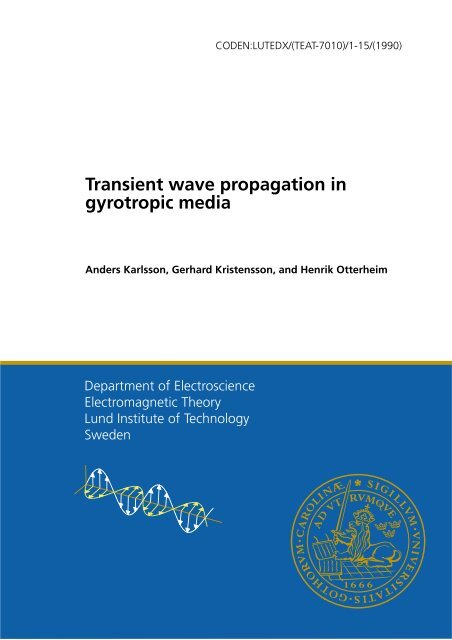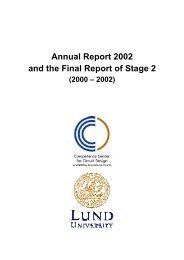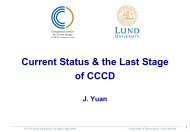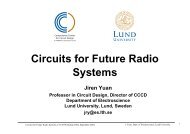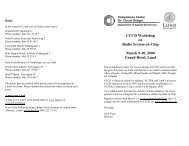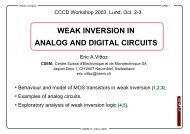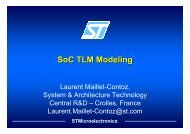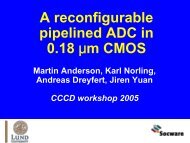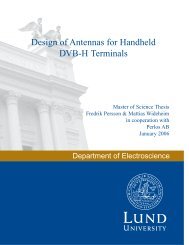Transient wave propagation in gyrotropic media - Lund Institute of ...
Transient wave propagation in gyrotropic media - Lund Institute of ...
Transient wave propagation in gyrotropic media - Lund Institute of ...
Create successful ePaper yourself
Turn your PDF publications into a flip-book with our unique Google optimized e-Paper software.
CODEN:LUTEDX/(TEAT-7010)/1-15/(1990)<br />
<strong>Transient</strong> <strong>wave</strong> <strong>propagation</strong> <strong>in</strong><br />
<strong>gyrotropic</strong> <strong>media</strong><br />
Anders Karlsson, Gerhard Kristensson, and Henrik Otterheim<br />
Department <strong>of</strong> Electroscience<br />
Electromagnetic Theory<br />
<strong>Lund</strong> <strong>Institute</strong> <strong>of</strong> Technology<br />
Sweden
Anders Karlsson and Henrik Otterheim<br />
Department <strong>of</strong> Electromagnetic Theory<br />
Royal <strong>Institute</strong> <strong>of</strong> Technology<br />
SE-100 44 Stockholm<br />
Sweden<br />
Gerhard Kristensson<br />
Department <strong>of</strong> Electromagnetic Theory<br />
<strong>Lund</strong> <strong>Institute</strong> <strong>of</strong> Technology<br />
P.O. Box 118<br />
SE-22100 <strong>Lund</strong><br />
Sweden<br />
Editor: Gerhard Kristensson<br />
c○ Anders Karlsson et al., <strong>Lund</strong>, September 17, 1994
Abstract<br />
In this paper transient electromagnetic <strong>wave</strong> <strong>propagation</strong> <strong>in</strong> an <strong>in</strong>homogeneous,<br />
cold plasma is considered. It is assumed that a constant magnetic<br />
<strong>in</strong>duction is present and that the plasma is spatially <strong>in</strong>homogeneous <strong>in</strong> the<br />
direction <strong>of</strong> the magnetic <strong>in</strong>duction. Losses <strong>in</strong> the plasma are modeled with a<br />
collision frequency ν. The direct problem, which is to calculate the reflected<br />
and transmitted responses <strong>of</strong> the plasma, is considered <strong>in</strong> this paper. Special<br />
attention is paid to the precursor effects <strong>in</strong> the plasma and several examples<br />
<strong>of</strong> precursor effects <strong>in</strong> an <strong>in</strong>homogeneous plasma are showed.<br />
1 Introduction<br />
One-dimensional <strong>propagation</strong> <strong>of</strong> transient <strong>wave</strong>s <strong>in</strong> dispersive <strong>media</strong> has traditionally<br />
been treated mostly <strong>in</strong> the frequency doma<strong>in</strong>. In some cases, e.g. when precursor<br />
effects are pronounced, this is probably the only way to treat these problems,<br />
see [4, pp. 316–326] and [7], s<strong>in</strong>ce the stationary phase method and related methods<br />
then can be used to obta<strong>in</strong> approximate solutions. However, there are a number<br />
<strong>of</strong> <strong>wave</strong> <strong>propagation</strong> problems <strong>in</strong> <strong>media</strong> where these effects are less pronounced,<br />
e.g. <strong>wave</strong> <strong>propagation</strong> <strong>in</strong> the ionosphere. In these cases, time doma<strong>in</strong> methods are<br />
an alternative to frequency doma<strong>in</strong> methods. Some advantages with time doma<strong>in</strong><br />
methods versus frequency doma<strong>in</strong> methods are that they facilitates the physical <strong>in</strong>terpretation<br />
<strong>of</strong> the results, the numerical implementation is simpler and the solutions<br />
obta<strong>in</strong>ed <strong>in</strong> the time doma<strong>in</strong> automatically satisfy causality.<br />
Recently, transient <strong>wave</strong> <strong>propagation</strong> <strong>in</strong> isotropic dispersive <strong>media</strong> has been treated<br />
<strong>in</strong> the time doma<strong>in</strong> us<strong>in</strong>g <strong>wave</strong> splitt<strong>in</strong>g and <strong>in</strong>variant imbedd<strong>in</strong>g techniques,<br />
see [1] and [5]. The ma<strong>in</strong> purpose for the development <strong>of</strong> a time doma<strong>in</strong> method<br />
for dispersive <strong>media</strong> was to solve the <strong>in</strong>verse problem, i.e. f<strong>in</strong>d<strong>in</strong>g the memory<br />
function which characterizes the medium, from reflection or transmission data. This<br />
is equivalent <strong>of</strong> f<strong>in</strong>d<strong>in</strong>g the dispersion relation <strong>in</strong> the frequency doma<strong>in</strong>. The same<br />
method can be applied to direct scatter<strong>in</strong>g from isotropic <strong>in</strong>homogeneous dispersive<br />
<strong>media</strong> and <strong>in</strong> some cases to the correspond<strong>in</strong>g <strong>in</strong>verse problem, see [3].<br />
In this paper scatter<strong>in</strong>g <strong>of</strong> transient electromagnetic fields from <strong>gyrotropic</strong> <strong>in</strong>homogeneous<br />
dispersive <strong>media</strong> is considered. The problem is one-dimensional with<br />
the pulse propagat<strong>in</strong>g normal to the stratification <strong>of</strong> the medium. The dispersion<br />
is modeled by a generalized Ohm’s law where the current density is expressed as a<br />
convolution <strong>of</strong> a conductivity kernel and the electric field. In the direct problem the<br />
explicit expression for the conductivity kernel is not crucial. However, <strong>in</strong> order to<br />
have a realistic model, e.g. <strong>of</strong> the ionosphere, a neutral plasma is considered. The<br />
conductivity kernel is then expressed <strong>in</strong> terms <strong>of</strong> the electron density and the collision<br />
frequency which are functions <strong>of</strong> depth <strong>in</strong> the medium. This choice <strong>of</strong> model<br />
is well suited for the <strong>in</strong>verse problem. S<strong>in</strong>ce the medium is anisotropic there are<br />
two <strong>in</strong>dependent reflected components <strong>of</strong> the field which are sufficient for the reconstruction<br />
<strong>of</strong> the electron density and the collision frequency. This <strong>in</strong>verse problem<br />
will be treated <strong>in</strong> a subsequent paper.<br />
1
This model <strong>of</strong> the ionosphere is, <strong>of</strong> course, too simple to be realistic. There are,<br />
however, a number <strong>of</strong> generalizations that can be made <strong>in</strong> order to make the model<br />
more realistic. Thus, the direction and the strength <strong>of</strong> the magnetic field may vary<br />
<strong>in</strong> the vertical direction. It is reasonable to <strong>in</strong>clude the effects <strong>of</strong> the motion <strong>of</strong><br />
the ions <strong>in</strong> the conductivity kernel s<strong>in</strong>ce they are <strong>of</strong> importance for the long time<br />
behavior <strong>of</strong> the scattered fields, see [2, p. 4]. An important extension <strong>of</strong> the method<br />
itself is to consider transient <strong>wave</strong>s at oblique <strong>in</strong>cidence. The phenomena that occur<br />
at oblique <strong>in</strong>cidence are <strong>of</strong> course strongly frequency dependent and it is <strong>of</strong> <strong>in</strong>terest<br />
to see how these phenomena show up <strong>in</strong> a time doma<strong>in</strong> treatment <strong>of</strong> the problem.<br />
These extensions are addressed <strong>in</strong> a subsequent paper.<br />
In appendix A, an alternative method <strong>of</strong> solv<strong>in</strong>g the direct problem for a homogeneous<br />
medium is discussed. Two Volterra equations <strong>of</strong> the second k<strong>in</strong>d are derived<br />
which solve the direct scatter<strong>in</strong>g problem and also the <strong>in</strong>verse scatter<strong>in</strong>g problem<br />
for a spatially homogeneous conductivity kernel. These Volterra equations are considerably<br />
much simpler and faster to solve numerically than the <strong>in</strong>tegro-differential<br />
equations which solve the <strong>in</strong>homogeneous problem.<br />
In a second appendix, appendix B, a reciprocity relationship for <strong>gyrotropic</strong> <strong>media</strong><br />
is presented. This relationship is used to show how the transmitted field from an<br />
<strong>in</strong>cident field from one side is related to the transmitted field from an <strong>in</strong>cident field<br />
from the other side.<br />
2 Gyrotropic medium without restor<strong>in</strong>g force<br />
In this section a generalized Ohm’s law is def<strong>in</strong>ed <strong>in</strong> the time doma<strong>in</strong> for a <strong>gyrotropic</strong><br />
medium.<br />
Consider a neutral plasma characterized by an electron density N(r), an effective<br />
collision frequency ν(r), and a constant magnetic <strong>in</strong>duction B0. If the positive<br />
charges are considered to be heavy and if the restor<strong>in</strong>g force between the electrons<br />
and the positive charges is neglected, the polarization <strong>of</strong> the plasma is governed by<br />
the equation <strong>of</strong> motion for the electrons<br />
m � ∂ 2 t r(t)+ν(r)∂tr(t) � = q (E(r,t)+∂tr × B0) ,<br />
where m and q are the mass and the charge <strong>of</strong> the electron, respectively. The<br />
magnetic field is oriented along the z direction, B0 =ˆzB0, and is assumed static<br />
(i.e. the static field B0 is assumed to be much greater than the <strong>in</strong>duced magnetic<br />
field due to the electromagnetic <strong>wave</strong>). By <strong>in</strong>troduc<strong>in</strong>g the def<strong>in</strong>ition <strong>of</strong> current<br />
density J<br />
J(r,t)=N(r)q∂tr<br />
the equation <strong>of</strong> motion becomes<br />
∂tJ(r,t)+ν(r)J(r,t)+ωgˆz × J(r,t)=ω 2 p(r)ɛ0E(r,t),<br />
where the <strong>gyrotropic</strong> frequency ωg and the plasma frequency ωp(r) are def<strong>in</strong>ed as<br />
ωg = qB0<br />
m , ω2 p(r) = N(r)q2<br />
ɛ0m .<br />
2
and ɛ0 is the permittivity <strong>of</strong> vacuum.<br />
A generalized Ohm’s law may be <strong>in</strong>troduced as (i =1, 2, 3 correspond to the x, y<br />
and z-directions, respectively) 1<br />
Ji(r,t) = � t<br />
−∞ Σij(r,t− t ′ )Ej(r,t ′ ) dt ′ =(Σij(r, ·) ∗ Ej(r, ·))(t)<br />
=(Σij ∗ Ej)(r,t).<br />
3<br />
(2.1)<br />
Notice the shorthand notation for the convolution <strong>in</strong>tegral <strong>in</strong>troduced <strong>in</strong> this equation.<br />
When the Ohm’s law is <strong>in</strong>serted <strong>in</strong>to the equation <strong>of</strong> motion the follow<strong>in</strong>g<br />
equation is obta<strong>in</strong>ed<br />
�<br />
Σij(r, 0) − ɛ0ω 2 �<br />
p(r)δij Ej(r,t)+(fij ∗ Ej)(r,t)=0,<br />
where<br />
fij(r,t)=∂tΣij(r,t)+ν(r)Σij(r,t)+ωgɛi3kΣkj(r,t),<br />
and ɛijk is the Levi-Civita density. S<strong>in</strong>ce the electric field is arbitrary, the conductivity<br />
kernel Σij(r,t) is determ<strong>in</strong>ed by<br />
� Σij(r, 0) = ɛ0ω 2 p(r)δij<br />
∂tΣij(r,t)+ν(r)Σij(r,t)+ωgɛi3kΣkj(r,t)=0.<br />
The unique solution to these equations is<br />
⎧<br />
⎪⎨<br />
⎪⎩<br />
Σ11(r,t)=Σ22(r,t)=ɛ0ω 2 p(r)e −ν(r)t cos ωgt<br />
Σ12(r,t)=−Σ21(r,t)=ɛ0ω 2 p(r)e −ν(r)t s<strong>in</strong> ωgt<br />
Σ33(r,t)=ɛ0ω 2 p(r)e −ν(r)t<br />
Σ13(r,t)=Σ23(r,t)=Σ31(r,t)=Σ32(r,t)=0.<br />
(2.2)<br />
There is no polarization or magnetization <strong>of</strong> the medium and thus the Maxwell<br />
equations are<br />
∇×E = −∂tB<br />
∇×B = µ0J + 1<br />
c 2 ∂tE<br />
where µ0 is the permeability <strong>of</strong> vacuum and where c =1/ √ µ0ɛ0 is the speed <strong>of</strong> light<br />
<strong>in</strong> vacuum.<br />
From these equations and the Ohm’s law, eq. (2.1), the <strong>wave</strong> equation <strong>in</strong> a<br />
source free region is obta<strong>in</strong>ed<br />
�<br />
∂k∂kδij − ∂i∂j − 1<br />
c2 ∂2 �<br />
t δij Ej(r,t) − 1<br />
c2 ∂t(Σij ∗ Ej)(r,t)=0. (2.3)<br />
1 The more general assumption Ji = aEi + ɛ0Σij ∗ Ej implies that a =0.
3 Scatter<strong>in</strong>g kernels and imbedd<strong>in</strong>g equations<br />
In this section we treat one-dimensional <strong>wave</strong> <strong>propagation</strong> <strong>in</strong> a stratified medium.<br />
In the region z0 the medium is assumed<br />
to be stratified <strong>in</strong> the vertical direction, i.e. <strong>in</strong> the z-direction. The medium is<br />
characterized by the conductivity kernel <strong>in</strong>troduced <strong>in</strong> the generalized Ohm’s law,<br />
eq. (2.1). The electromagnetic field is assumed to be vertically propagat<strong>in</strong>g and the<br />
follow<strong>in</strong>g shorthand notation for the electric field will be used<br />
E(z,t) =ˆxE1(z,t)+ˆyE2(z,t).<br />
S<strong>in</strong>ce the z-component <strong>of</strong> the field is zero, all matrices are 2 × 2 and will be written<br />
boldface without <strong>in</strong>dices. The follow<strong>in</strong>g short-hand notation for a matrix product<br />
and a convolution <strong>of</strong> two matrices will be used<br />
AB = Ai1B1j + Ai2B2j<br />
A ∗ B = Ai1 ∗ B1j + Ai2 ∗ B2j.<br />
All matrices can be shown to commute with each other and the equations can be<br />
written formally us<strong>in</strong>g this shorthand matrix notation. The <strong>wave</strong> equation (2.3)<br />
simplifies to<br />
∂ 2 zE(z,t) − c −2 ∂ 2 t E(z,t) − c −2 ∂t(Σ ∗ E)(z,t) =0.<br />
The two coupled second order PDE’s can be rewritten as four coupled first order<br />
PDE’s, which <strong>in</strong> a matrix notation read<br />
� �<br />
E(z,t)<br />
∂z<br />
= c<br />
∂zE(z,t)<br />
−2<br />
��<br />
2 0 c 1<br />
1∂2 � � �� � �<br />
0 0 E(z,t)<br />
+<br />
t 0 Σ ∗ ∂t 0 ∂zE(z,t)<br />
� �<br />
E(z,t)<br />
= A<br />
,<br />
∂zE(z,t)<br />
where (Σ ∗ ∂tE)(z,t) = � t<br />
−∞ Σ(z,t − t′ )∂t ′E(z,t′ ) dt ′ , 1 is the 2 × 2 unit matrix and<br />
0 is the 2 × 2 zero matrix.<br />
In the homogeneous region, z0<br />
E ± (z,t) = 1 � −1<br />
E(z,t) ∓ c∂t ∂zE(z,t)<br />
2<br />
�<br />
where ∂ −1<br />
t ∂zf(z,t) = � t<br />
−∞ ∂zf(z,t ′ ) dt ′ .<br />
In a matrix notation this change <strong>of</strong> basis reads<br />
�<br />
+ E (z,t)<br />
E− �<br />
(z,t)<br />
= 1<br />
2<br />
��<br />
E(z,t)<br />
∂zE(z,t)<br />
= P<br />
� 1 −1c∂ −1<br />
t<br />
1 1c∂ −1<br />
t<br />
� E(z,t)<br />
∂zE(z,t)<br />
�<br />
.<br />
�<br />
4<br />
(3.1)
The formal <strong>in</strong>verse <strong>of</strong> the operator P is<br />
P −1 �<br />
=<br />
1 1<br />
−1c −1 ∂t 1c −1 ∂t<br />
The <strong>wave</strong> equation can now be rewritten <strong>in</strong> terms <strong>of</strong> four coupled first order<br />
PDE’s for the plus and m<strong>in</strong>us fields<br />
�<br />
+ E (z,t)<br />
∂z<br />
E− �<br />
= PAP<br />
(z,t)<br />
−1<br />
�<br />
+ E (z,t)<br />
E− �<br />
(z,t)<br />
=<br />
�<br />
c−1 �<br />
−1 0<br />
0 1<br />
�<br />
�<br />
.<br />
∂t + 1<br />
�<br />
−Σ −Σ<br />
2 Σ Σ<br />
�� � E + (z,t)<br />
E − (z,t)<br />
�<br />
.<br />
5<br />
(3.2)<br />
From Duhamel’s pr<strong>in</strong>ciple it can be shown that there exists a l<strong>in</strong>ear relation<br />
between the plus and the m<strong>in</strong>us parts <strong>of</strong> the electric field<br />
E − (z,t) =(R ∗ E + )(z,t). (3.3)<br />
The kernel R(z,t) is referred to as the reflection matrix kernel. For z < 0 the<br />
reflection matrix kernel then relates the reflected field to the <strong>in</strong>cident field.<br />
An <strong>in</strong>tegro-differential equation, referred to as the imbedd<strong>in</strong>g equation, can be<br />
obta<strong>in</strong>ed for the reflection matrix kernel by utiliz<strong>in</strong>g the equations (3.2) and (3.3).<br />
Differentiate eq. (3.3) with respect to z and use the dynamics <strong>of</strong> the fields E ± , eq.<br />
(3.2). After lengthy calculations the follow<strong>in</strong>g equations are obta<strong>in</strong>ed:<br />
and<br />
2c∂zR − 4∂tR = Σ + Σ ∗ R + R ∗ Σ + R ∗ Σ ∗ R (3.4)<br />
R(z,0) = 0, z ≥ 0.<br />
Assum<strong>in</strong>g unique solvability <strong>of</strong> these equations gives R11 = R22 and R12 = −R21,<br />
which also can be concluded from symmetry arguments, and the explicit equations<br />
read<br />
2c∂zR11 − 4∂tR11 =Σ11 +(Σ11 ∗·)[2R11 + R11 ∗ R11 − R12 ∗ R12]<br />
−2(Σ12 ∗·)[R12 + R11 ∗ R12]<br />
2c∂zR12 − 4∂tR12 =Σ12 + 2(Σ11 ∗·)[R12 + R11 ∗ R12]<br />
+(Σ12 ∗·)[2R11 + R11 ∗ R11 − R12 ∗ R12] ,<br />
If the medium is <strong>of</strong> f<strong>in</strong>ite length, L, the R-kernels satisfy the boundary conditions<br />
R11(L, t) =R12(L, t) =0.<br />
(3.5)
The transmitted field through a medium <strong>of</strong> f<strong>in</strong>ite length L is related to the<br />
<strong>in</strong>cident field as follows<br />
E + (L, t + L/c) =D(0)E + (0,t)+(T ∗ E + )(0,t).<br />
This representation can be generalized to the region 0
Here E + (z,t+ z/c) and E − (z,t+ z/c) are the splitted fields <strong>in</strong>side the medium, i.e.<br />
E + (z,t + z/c) and E − (z,t + z/c) are related to E(z,t + z/c) and ∂zE(z,t + z/c),<br />
by eq. (3.1), and the kernels G + and G − are the Green functions for the time<br />
dependent problem. It should be noted that time t is measured from the <strong>wave</strong>front.<br />
It is straightforward to derive equations for the Green functions us<strong>in</strong>g a similar<br />
technique as <strong>in</strong> the previous section.<br />
The z-derivative <strong>of</strong> (4.1) reads<br />
�<br />
+ E<br />
∂z<br />
E− �<br />
(z,t + z/c)+ 1<br />
c ∂t<br />
�<br />
+ E<br />
E− �<br />
� +<br />
G z (z,t) ∗ E<br />
(z,t + z/c) =<br />
+ (0,t)<br />
G −<br />
z (z,t) ∗ E + (0,t)<br />
By us<strong>in</strong>g the dynamics for E + (z,t+ z/c) and E − (z,t+ z/c), eq. (3.2), the follow<strong>in</strong>g<br />
system <strong>of</strong> PDE’s is obta<strong>in</strong>ed<br />
− 1<br />
�<br />
∂t +<br />
c<br />
1<br />
� �� �� � �<br />
+<br />
+ + Σ∗ −Σ∗ E G (z,t) ∗ E (0,t)<br />
(0,t)+<br />
2 −Σ∗ Σ∗ 0<br />
−G − (z,t) ∗ E + ��<br />
+<br />
(0,t)<br />
+ 1<br />
� � +<br />
E t +<br />
c 0<br />
1<br />
c ∂t<br />
� + + G (z,t) ∗ E (0,t)<br />
G − (z,t) ∗ E + �<br />
�<br />
=<br />
.<br />
(0,t)<br />
� G +<br />
z (z,t) ∗ E + (0,t)<br />
G −<br />
z (z,t) ∗ E + (0,t)<br />
S<strong>in</strong>ce the <strong>in</strong>com<strong>in</strong>g field, E + (0,t), is an arbitrary function <strong>of</strong> t, the Green functions<br />
have to satisfy the follow<strong>in</strong>g <strong>in</strong>tegro-differential equations<br />
and the <strong>in</strong>itial conditions<br />
G +<br />
z = − 1<br />
G −<br />
z − 2<br />
c G−<br />
t = 1<br />
2c<br />
� Σ + Σ ∗ � G + + G − ��<br />
2c<br />
� � + −<br />
Σ + Σ ∗ G + G �� ,<br />
G − (z,0) = 0<br />
G + (z,0) = − 1<br />
� z<br />
Σ(0,z<br />
2c 0<br />
′ )dz ′ .<br />
Thus the Green functions satisfy a system <strong>of</strong> four coupled first order PDE’s. Unlike<br />
the imbedd<strong>in</strong>g equations for the reflection and transmission kernels, the equations<br />
for the Green functions do not conta<strong>in</strong> any double convolutions. Numerically,<br />
these equations are then one order faster to solve than the imbedd<strong>in</strong>g equations. It<br />
should be noted that the boundary values <strong>of</strong> the Green functions are<br />
G + (0,t) = 0<br />
G − (0,t) = R(0,t)<br />
G + (L, t + L/c) = T (0,t)<br />
G − (L, t) = 0.<br />
A limitation <strong>of</strong> the Green function technique is that numerically it requires the<br />
storage <strong>of</strong> gridpo<strong>in</strong>ts <strong>in</strong> both time and space. Thus N × N arrays have to be stored<br />
whereas <strong>in</strong> the numerical solution <strong>of</strong> the imbedd<strong>in</strong>g equations for the reflection and<br />
transmission kernels only N × 1arrays have to be stored.<br />
�<br />
7
Figure 1: The plasma frequency given by the Chapman pr<strong>of</strong>ile.<br />
5 Numerical examples<br />
In the numerical examples presented <strong>in</strong> this section it was necessary to use around<br />
1000 po<strong>in</strong>ts <strong>in</strong> both the z− and t−discretizations. The Green function technique<br />
would require on the order <strong>of</strong> 30 MB <strong>of</strong> <strong>in</strong>ternal memory and thus only the <strong>in</strong>variant<br />
imbedd<strong>in</strong>g technique has been used.<br />
A straightforward discretization <strong>of</strong> the equations for the reflection and transmission<br />
kernels, eqs. (3.5) and (3.8) is obta<strong>in</strong>ed by an application <strong>of</strong> the trapezoidal rule.<br />
The equations are <strong>in</strong>tegrated along their characteristics, i.e. along 2z/c−t =constant<br />
and z =constant, respectively, by the trapezoidal rule. The stepsize <strong>in</strong> z and <strong>in</strong> t are<br />
then coupled to each other by ∆z =∆tc/2. As shown <strong>in</strong> the first example below, the<br />
coupl<strong>in</strong>g <strong>of</strong> the discretization <strong>in</strong> space and time sometimes leads to time consum<strong>in</strong>g<br />
numerical calculations.<br />
In the first example the z−dependence <strong>of</strong> the conductivity kernel is chosen accord<strong>in</strong>g<br />
to the Chapman law, cf. [2, p. 9]. The Chapman law is a simplified model<br />
<strong>of</strong> the ionosphere where the electron density is given by<br />
N(z) =N0 exp{ 1 (z − z0)<br />
(1 − − exp(<br />
2 H<br />
z0 − z<br />
H )}.<br />
In this example, the reference height, H, is choosen to be 10 km, the height for the<br />
maximum electron density, z0, is115km and the maximum electron density, N0, is<br />
2.8 × 10 11 m −3 .<br />
The correspond<strong>in</strong>g plasma frequency as a function <strong>of</strong> z is shown <strong>in</strong> figure 1. A<br />
constant collision frequency, ν =100Hz, is assumed and the <strong>gyrotropic</strong> frequency<br />
is ωg =10 6 rad/s which is <strong>in</strong> accordance with the earth magnetic <strong>in</strong>duction. There<br />
are two time-scales <strong>in</strong>volved <strong>in</strong> this problem. The first time-scale is def<strong>in</strong>ed by the<br />
period <strong>of</strong> the <strong>gyrotropic</strong> frequency and the other time-scale is def<strong>in</strong>ed by the time it<br />
takes for the <strong>wave</strong>-front to pass through the ma<strong>in</strong> part <strong>of</strong> the medium. The timescales<br />
then differ with three orders <strong>of</strong> magnitude and it is the smallest <strong>of</strong> these scales<br />
that will determ<strong>in</strong>e the step-size <strong>in</strong> both time and space.<br />
8
Figure 2: The reflection kernels.<br />
Figure 3: The plasma frequency ωp(z) =2.5 × 10 6 − 2.5 × 10 6 cos(2πz/L) rad/s.<br />
As expected the kernels reflect the smooth behavior <strong>of</strong> the pr<strong>of</strong>ile. However,<br />
when the curves are magnified it is possible to see a signal, superimposed on the<br />
smooth curve, that oscillates with the <strong>gyrotropic</strong> frequency. From figure 2 it is seen<br />
that the reflection kernels R11 and R12 are out <strong>of</strong> phase. This can be understood<br />
from eq. (3.5) where it is seen that the time derivative <strong>of</strong> the reflection R12 has the<br />
same source term as R11.<br />
It is likely that precursor effects can occur <strong>in</strong> a <strong>gyrotropic</strong> medium s<strong>in</strong>ce it has<br />
the same structure as a Lorentz medium, cf. [4]. The first precursor is essentially<br />
determ<strong>in</strong>ed by the <strong>in</strong>itial values <strong>of</strong> the conductivity kernel and its first derivative,<br />
whereas the second precursor is caused by the <strong>in</strong>ternal resonance frequency <strong>of</strong> the<br />
medium, i.e <strong>in</strong> this case the <strong>gyrotropic</strong> frequency. In the second example the magnitude<br />
<strong>of</strong> the material parameters and the length <strong>of</strong> the medium were chosen so that<br />
both the first and the second precursor could be seen <strong>in</strong> the transmission kernels.<br />
9
The plasma frequency varies like<br />
Figure 4: The transmission kernels.<br />
ωp(z) =2.5 × 10 6 − 2.5 × 10 6 cos(2πz/L) rad/s<br />
where L =2km, as seen <strong>in</strong> figure 3, and the <strong>gyrotropic</strong> frequency is ωg =5×<br />
106 rad/s.<br />
The values are realistic for the ionosphere, i.e. it should be possible to see both<br />
the first and the second precursor <strong>in</strong> a time doma<strong>in</strong> experiment. As seen <strong>in</strong> figure 4,<br />
the transmission kernel first has an oscillatory behavior, where the frequency <strong>of</strong> the<br />
oscillations decreases with time. This part <strong>of</strong> the transmission kernel corresponds to<br />
the first � precursor. In the case <strong>of</strong> a homogeneous plasma it is approximately equal<br />
L to ωp 2ctJ1(ωp �<br />
2Lt<br />
c ), where L is the lenghth <strong>of</strong> the medium and J1 is the Bessel<br />
function <strong>of</strong> the first order. After a certa<strong>in</strong> time there is a second oscillation <strong>of</strong> the<br />
transmission kernel that appears. It corresponds to the second precursor and has a<br />
less rapid variation then the first precursor. Accord<strong>in</strong>g to [4] the second precursor<br />
is delayed a time ts � L ωp<br />
( 2c ωg )2 � 3µs relative to the <strong>wave</strong>-front which is <strong>in</strong> good<br />
agreement with figure 4.<br />
6 Conclusions<br />
In the present paper, reflection and transmission from a <strong>gyrotropic</strong> medium are analyzed.<br />
A constitutive relation, based upon the equation <strong>of</strong> motion for the electrons,<br />
is <strong>in</strong>troduced and it is seen that <strong>in</strong> the time doma<strong>in</strong> the medium is characterized by<br />
a conductivity kernel which acts as a memory function for the medium. The reflection<br />
and transmission kernels for the plasma are calculated us<strong>in</strong>g the <strong>wave</strong> splitt<strong>in</strong>g<br />
and the <strong>in</strong>variant imbedd<strong>in</strong>g technique. The solution is implicitly given as coupled<br />
<strong>in</strong>tegro-differential equations for the scatter<strong>in</strong>g kernels. Numerical solutions to these<br />
equations are presented for a simplified model <strong>of</strong> the ionosphere and also to a denser<br />
plasma with a large magnetic <strong>in</strong>duction where precursor effects appear.<br />
10
An alternative method to the <strong>in</strong>variant imbedd<strong>in</strong>g method is also discussed <strong>in</strong><br />
this paper. In this method coupled PDE’s for the Green functions are obta<strong>in</strong>ed. This<br />
method is used <strong>in</strong> a subsequent paper to obta<strong>in</strong> the <strong>in</strong>ternal fields <strong>in</strong> a <strong>gyrotropic</strong><br />
medium at oblique <strong>in</strong>cidence, and where also the precursors <strong>in</strong> the ionosphere are<br />
addressed <strong>in</strong> more detail.<br />
Appendix A The homogeneous plasma<br />
In this appendix it is shown that the reflection and transmission kernels for a homogeneous<br />
plasma, i.e. where ωp and ν are constant, can be obta<strong>in</strong>ed by solv<strong>in</strong>g<br />
two Volterra equations <strong>of</strong> the second k<strong>in</strong>d. Numerically, these Volterra equations<br />
are one order faster to solve than the <strong>in</strong>tegro-differential equations. The equations<br />
are derived by a Laplace transformation <strong>of</strong> eqs. (3.4) and (3.7).<br />
For a plasma <strong>of</strong> f<strong>in</strong>ite length, L, one round-trip, τ, is def<strong>in</strong>ed as the time it takes<br />
for the <strong>wave</strong>-front to go back and forth once <strong>in</strong> the medium, i.e. τ =2L/c. For a<br />
homogeneous plasma the reflection matrix kernel is <strong>in</strong>dependent <strong>of</strong> z for times less<br />
than one round-trip and thus the equation for the reflection matrix kernel, eq. (3.4)<br />
can be <strong>in</strong>tegrated <strong>in</strong> time to give<br />
4R + G + G ∗ R + R ∗ G + R ∗ G ∗ R =0, 0
where<br />
By <strong>in</strong>troduc<strong>in</strong>g<br />
˜v(s) can be written as<br />
˜v(s) =˜r(s) exp(− ˜ Φ(s)).<br />
˜e(s) = exp(− ˜ Φ(s)/2) − 1,<br />
˜v(s) =˜v(s)(˜e(s)) 2 +2˜r(s)˜e(s)+˜r(s).<br />
In the time doma<strong>in</strong> the reflection matrix kernel thus has the follow<strong>in</strong>g series expansion<br />
∞�<br />
R(0,t)=r(t)+ [(r ∗ r ∗ v − v)(∗r ∗ v) n ](t − (n +1)τ), (A.4)<br />
n=0<br />
where r(t) and v(t) are the <strong>in</strong>verse Laplace transforms <strong>of</strong> ˜r(s) and ˜v(s), respectively,<br />
and where the terms on the right hand side are understood to be zero for<br />
negative arguments. The series expansion then corresponds to a multiple scatter<strong>in</strong>g<br />
expansion. From eq. (A.4) it is obvious that r(t) is the reflection matrix kernel for<br />
times less than one round-trip. This can also be seen by deriv<strong>in</strong>g eq. (A.1) from the<br />
expression <strong>in</strong> eq. (A.3). Thus r(t) satisfies the equation<br />
The matrix v(t) is obta<strong>in</strong>ed from<br />
4r + G +2G ∗ r + r ∗ G ∗ r =0. (A.5)<br />
v = r ∗ e ∗ e +2r ∗ e + r. (A.6)<br />
The matrix e(t) satisfies the follow<strong>in</strong>g Volterra equation <strong>of</strong> the second k<strong>in</strong>d<br />
where<br />
2te(t)+[f ∗ e](t)+f(t) =0, (A.7)<br />
f(t) =tΦ(t).<br />
and Φ(t) is the <strong>in</strong>verse Laplace transform <strong>of</strong> ˜ Φ(s), which can be written as<br />
Φ(t) = τ<br />
{(Σ ∗ r)(t)+Σ(t)}<br />
2<br />
as seen from eqs. (A.2) and (A.3). The Volterra equation (A.7) is easy to derive by<br />
notic<strong>in</strong>g that<br />
2∂s˜e(s) =−(∂s ˜ Φ(s)) exp(− ˜ Φ(s)/2) = −(∂s ˜ Φ(s))˜e(s) − ∂s ˜ Φ(s)<br />
and us<strong>in</strong>g that the <strong>in</strong>verse Laplace transform <strong>of</strong> ∂s ˜ Φ(s) is−tΦ(t).<br />
12
It is seen that the reflection matrix kernel can be obta<strong>in</strong>ed by solv<strong>in</strong>g two Volterra<br />
equations <strong>of</strong> the second k<strong>in</strong>d, eqs. (A.5) and (A.7), and by perform<strong>in</strong>g the convolutions<br />
and summations <strong>in</strong> eqs. (A.6) and (A.4).<br />
The Laplace transform <strong>of</strong> the equation for the transmission kernels, eq. (3.7),<br />
reads<br />
2c∂3 ˜ T = ˜ Σ(1+ ˜ R)(1+ ˜ T ).<br />
If ˜ R and ˜ T commute, the formal solution to this equation at z = 0 reads<br />
and thus <strong>in</strong> the time doma<strong>in</strong><br />
˜T (0,s)=−˜r(s) ˜ R(s)+˜e(s)(1 − ˜r(s) ˜ R(s))<br />
T (0,t)=e(t) − [r ∗ R](t) − [e ∗ r ∗ R](t).<br />
Appendix B A reciprocity relationship<br />
A <strong>gyrotropic</strong> medium is <strong>in</strong> general not reciprocal. It is, however, possible to prove a<br />
reciprocity relationship by <strong>in</strong>troduc<strong>in</strong>g a complementary medium. This is the same<br />
idea that is used <strong>in</strong> [6] for bianisotropic <strong>media</strong>. The reciprocity theorem will then<br />
be used to prove that the transmission kernel for an <strong>in</strong>cident <strong>wave</strong> propagat<strong>in</strong>g <strong>in</strong><br />
the positive z−direction is identical to the transmission kernel for an <strong>in</strong>cident <strong>wave</strong><br />
travel<strong>in</strong>g <strong>in</strong> the negative z−direction.<br />
Let {E, H} be the electromagnetic field satisfy<strong>in</strong>g the Ohm’s law, eq. (2.1), and<br />
let {E c , H c } be an <strong>in</strong>dependent electromagnetic field satisfy<strong>in</strong>g the Ohms law for a<br />
complementary medium<br />
J c i =Σji ∗ E c j<br />
13<br />
(B.1)<br />
i.e. with the transpose <strong>of</strong> the orig<strong>in</strong>al conductivity kernel. This corresponds to<br />
revers<strong>in</strong>g the direction <strong>of</strong> the magnetic <strong>in</strong>duction B0. Both <strong>media</strong> are otherwise<br />
identical and the conductivity kernel is given by eq. (2.2). From the Maxwell equations,<br />
the Ohm’s laws given by eqs. (2.1) and (B.1) for the medium and the complementary<br />
medium, respectively, and by use <strong>of</strong> Gauss’ law the follow<strong>in</strong>g reciprocity<br />
relationship is seen to hold<br />
�� � t<br />
{ɛijk(E c j(t ′ )Hk(t − t ′ )+H c j (t ′ )Ek(t − t ′ ))}dt ′ ˆnidS =0. (B.2)<br />
S 0<br />
The surface S is closed and ˆni is its outward po<strong>in</strong>t<strong>in</strong>g normal.<br />
Now, let the medium be stratified <strong>in</strong> the z-direction and extend from z =0to<br />
z = L. Outside the medium there is vacuum. Let E(z,t) be the total field from an<br />
<strong>in</strong>cident field propagat<strong>in</strong>g <strong>in</strong> the negative z−direction for z>L, i.e. from E − (z,t) =<br />
ˆxE− x (L, t +(z − L)/c), and let E c (z,t) be the total field for the complementary<br />
medium from an <strong>in</strong>cident field propagat<strong>in</strong>g <strong>in</strong> the positive z−direction for z
on the slab at time t = 0, i.e. E(L, t) =E c (0,t)=0fort
References<br />
[1] R.S. Beezley and R.J. Krueger. An electromagnetic <strong>in</strong>verse problem for dispersive<br />
<strong>media</strong>. J. Math. Phys., 26(2):317–325, 1985.<br />
[2] K.G. Budden. The <strong>propagation</strong> <strong>of</strong> radio <strong>wave</strong>s. Cambridge University Press,<br />
Cambridge, 1985.<br />
[3] J.P. Corones and A. Karlsson. <strong>Transient</strong> direct and <strong>in</strong>verse scatter<strong>in</strong>g for <strong>in</strong>homogeneous<br />
viscoelastic <strong>media</strong>: obliquely <strong>in</strong>cident sh mode. Inverse Problems,<br />
4:643–660, 1988.<br />
[4] J. D. Jackson. Classical Electrodynamics. John Wiley & sons, New York, second<br />
edition edition, 1975.<br />
[5] A. Karlsson. Inverse scatter<strong>in</strong>g for viscoelastic <strong>media</strong> us<strong>in</strong>g transmission data.<br />
Inverse Problems, 3:691–709, 1987.<br />
[6] J. A. Kong. Reciprocity relationships for bianisotropic <strong>media</strong>. Proc. IEEE (Letters),<br />
58(12):1966–1967, 1970.<br />
[7] K.E. Oughstun and G.C. Sherman. Propagation <strong>of</strong> electromagnetic pulses <strong>in</strong><br />
a l<strong>in</strong>ear dispersive medium with absorption (the lorentz medium). J.Opt. Soc.<br />
Am. B, 5(4):817–849, 1988.<br />
15


